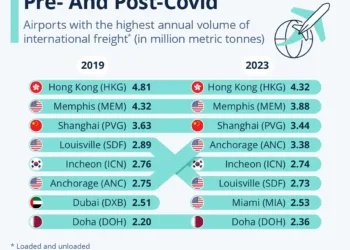Overview of Southern Border Apprehensions Trends in FY2024
The Southern United States border has been a focal point of political discussions for years, particularly regarding undocumented immigration. Recent statistics from U.S. Customs and Border Protection reveal a significant drop in apprehensions during the fiscal year 2024, showing a decrease of around 25%. This decline offers a new perspective on the challenges and dynamics of immigration policy in the U.S.
The Context of Border Apprehensions
High figures of undocumented immigrants apprehended at the Southern border have led to political tensions and discussions over the effectiveness of enforcement and policy approaches. The complex interplay of humanitarian concerns and strict immigration policies has defined the narrative surrounding unauthorized entries, particularly under the Biden Administration, which sought to balance these tensions despite criticism from opposing political factions.
Historical Patterns of Immigration
The Spike of 2019
The rise in apprehensions during the fiscal year 2019 was largely attributed to an influx of migrants from Central America. This surge was marked by family units seeking asylum due to violence and instability in their home countries. The situation intensified the debate over how the U.S. should handle undocumented migrants, leading to controversial policies aimed at deterrence, such as family separations.
The Trump Administration’s Policies
The Trump administration introduced numerous policies that significantly affected immigration patterns. The policy of separating families at the border aimed to deter migration but drew widespread condemnation and legal challenges. Furthermore, the "Remain in Mexico" policy mandated that asylum seekers wait in Mexico for their court hearings, a measure that still remains in effect despite various attempts to end it.
Post-Pandemic Immigration Dynamics
The Impact of COVID-19
The COVID-19 pandemic disrupted many aspects of life, including immigration flows. In 2020, there was a noticeable drop in crossings. However, as restrictions eased, the trend reversed and led to another upsurge in undocumented immigrants arriving at the Southern border. This increase was not only due to migrants from Central America but also reflected a resurgence in migration from Mexico, which signaled a complex and changing landscape of immigration.
A Shift in Nationalities
Historically, Mexico has been the primary source of undocumented immigrants to the U.S., primarily consisting of male labor migrants. However, recent years have seen a notable shift in the demographics of those apprehended. In 2024, more than 1 million non-Mexican migrants were apprehended. Notably, around one-third of these migrants hailed from El Salvador, Guatemala, and Honduras, indicating that the profile of border crossers is increasingly diverse compared to previous years.
The Implications of Changing Patterns
The shift in migration demographics bears significant implications for U.S. immigration policy. It highlights the need for tailored approaches to meet the challenges posed by different groups of migrants. The current situation suggests a need for comprehensive reform to address the humanitarian aspects while ensuring border security.
Conclusion
As the dynamics of immigration at the Southern border continue to evolve, policymakers are faced with the challenge of crafting solutions that balance enforcement with the humanitarian needs of migrants. The reduction in apprehensions in FY2024 provides a glimpse into the changing landscape and the complexities involved in managing immigration in an era marked by political and social shifts.












